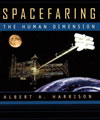
Like many of you, I’m a total advocate for human space exploration. Sure, robots are great, with their indestructibility and unquestioning loyalty, but there are times when you really need to get some human hands and eyes on location to provide some solid data and deal with the unexpected. But humans are soft, fragile, and can sometimes get a little grumpy.
Like many of you, I’m a total advocate for human space exploration. Sure, robots are great, with their indestructibility and unquestioning loyalty, but there are times when you really need to get some human hands and eyes on location to provide some solid data and deal with the unexpected. But humans are soft, fragile, and can sometimes get a little grumpy.
Spacefaring: the Human Dimension by Albert Harrison helps fill a niche that I’ve found largely unfilled in most of the space exploration books I’ve read – how to keep humans alive, and stop them from killing each other during long space trips. And by focusing only on this aspect of space travel, Harrison gives the subject matter the time and respect it deserves. Each element is covered in tremendous detail, including the basics of food, air, water, heat, etc. but also the more psychological elements of coping with stress, group dynamics, training, and dealing with mistakes and disasters. Harrison throws in a plenty of anecdotes to give real world examples to the topics covered.
I’d recommend this book to anyone who finds this aspect of space exploration fascinating. I’d especially recommend it to folks like the Mars Society, as many of the issues have been largely ignored by NASA so far. And I’d force scriptwriters and directors to read this book before they make another Mission to Mars. Great book!
Click here to read more about this book at Amazon.com.
